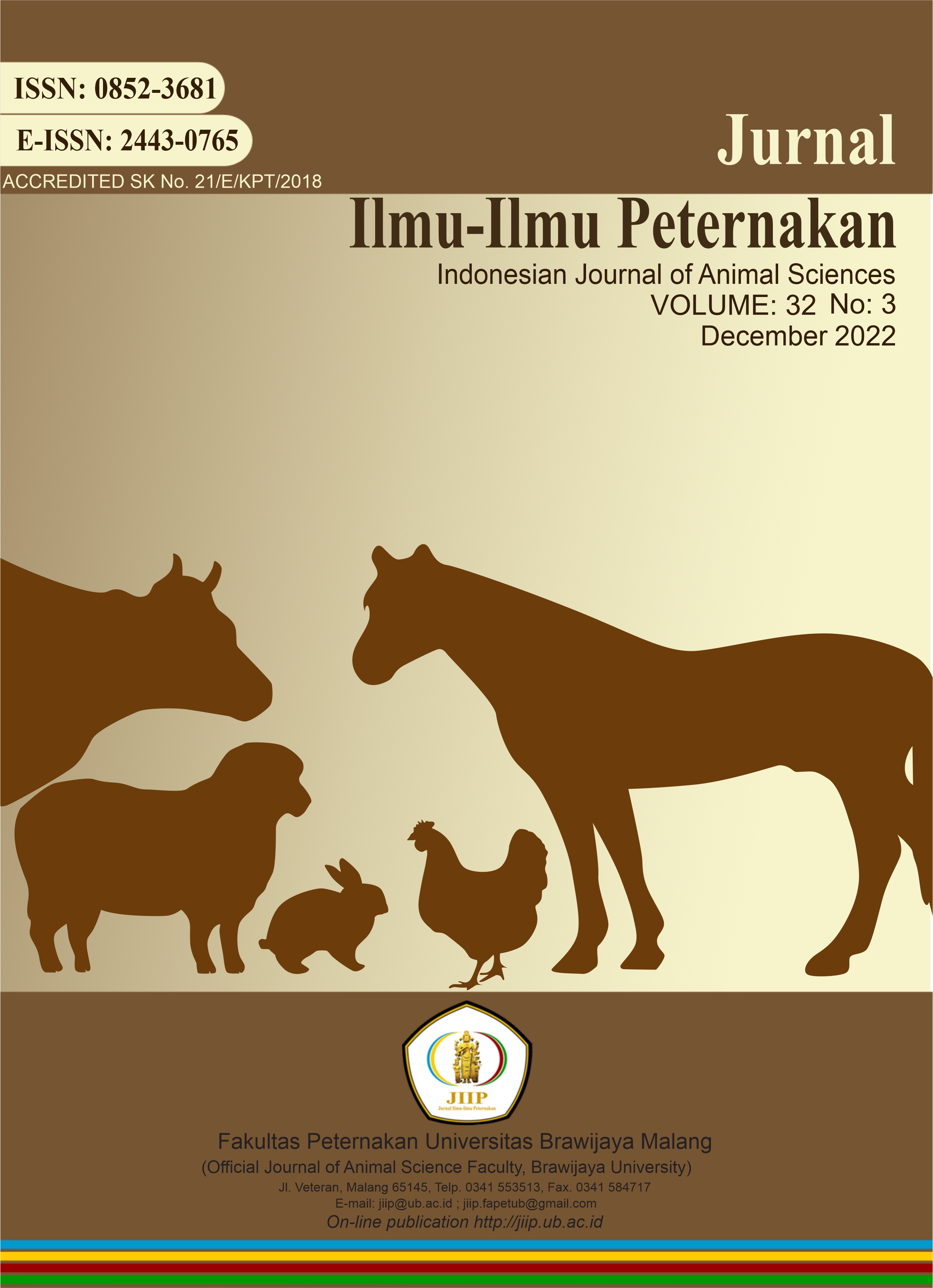Database of Nutrition Status, Production and Reproduction Performance, and Social Economy of a Farmer of a Beef Cattle Farm in Sumberpucung District, Malang Regency
DOI:
https://doi.org/10.21776/ub.jiip.2022.032.03.06Keywords:
Database of beef cattle, Nutritional status, Production, Reproduction, Socioeconomics.Abstract
Sumberpucung District, Malang Regency has the potential for developing beef cattle. This study aimed to analyze the nutrition status, production, and reproduction performance of beef cattle as well as examine the socio-economic of farmers. The research method is a survey to obtain a database about beef cattle kept by a farmer. This study involved 50 respondents spread over 4 villages, namely Senggreng, Jatiguwi, Trenyang, and Sambigede. The results of the research showed that the average age of farmers was only 14% who were under 40 years old. The number of cattle ownership was an average of 2-3 heads with the largest breed of cattle being Simmental crossbreeds. The system of breeding and rearing was wholly AI and in the cage. Feed that was usually given in general was rice straw followed by corn straw, sugarcane top, elephant grass, field grass, and rice bran. The average feed intake of rice straw, corn straw, and elephant grass were 17.865 – 22.9 kg/head/day, 10.23 – 20.5 kg/head/day, and 17-31.3 kg/head/day respectively. The chest girth of the male adult group had the highest value of 162.5 cm and the female adult group of 165.7 cm. The highest estimated live weights for male and female adults in Jatiguwi village were 340.40 kg and 352.31 kg respectively. The highest and the lowest average gestation length were 235 days and 224 days respectively. The highest and the lowest average of S/C were 5.5 times and once. The average calving interval of a cow in Senggreng, Trenyang, Sambigede, and Jatiguwi villages were 440 days, 399 days, 420 days, and 403 days respectively. The number of cattle that were pregnant in the first AI, second AI, and more than the second AI were 27 heads, 32 heads, and 24 heads. Based on the type of feed and its intake, it can be said that the nutrition status of beef cattle in Sumberpucung District is highly good. Effects of nutrition status can be seen from the performance of production and reproduction of cattle in terms of chest girth, live weight, and calving interval.
References
Al-amin, A. F., M. Hartono, dan S. Suharyati. 2017. Faktor-Faktor Yang Memengaruhi Calving Interval Sapi Perah Pada Peternakan Rakyat Di Beberapa Kabupaten/Kota Provinsi Lampung. Jurnal Riset dan Inovasi Peternakan, 1(1) : 33-36.
Badan Pusat Statistik (BPS) Kabupaten Malang. 2019. BPS Kabupaten Malang, Malang.
Heryani, L. G. S. S., N. N. W. Susari dan I. W. N. F. Gunawan. 2018. Variabel komponen Utama Pada Morfometrik Sapi Putih Taro Berdasarkan Pengukuran Badan. Buletin Veteriner Udayana. 10(1):93-99.
Iqbal, M., A. Husni., S. Sulastri., dan E.Y.M. Putri. 2019. Profil Peternakan Dan Performa Kuantitatif Sapi Peranakan Ongole Betina Di Sentra Peternakan Rakyat Kabupaten Lampung Selatan Dan Lampung Timur. Suluh Pembangunan: Journal Of Extension And Development, 1(2) : 115-121.
Indrayani, I., & A. Andri. (2018). Faktor-faktor yang Mempengaruhi Pendapatan Usaha Ternak Sapi potong di Kecamatan Sitiung, Kabupaten Dharmasraya. Jurnal Peternakan Indonesia. 20(3), 151-159.
Kaufmann, T. B., M. Drillich., B.A. Tenhagen., D. Fonderung., and W. Heuwiser. 2009. Prevalence of Bovine Subclinical Endometritis 4 H After Insemination and Its Effects on First Service Conception Rate. Theriogenology, 71(2) : 385-391.
Pratami, R., D. Kurnia., dan P. Anwar. 2019. Evaluasi Tingkat Keberhasilan Pelaksanaan Program Inseminasi Buatan Pada Sapi Bali Di Kecamatan Logas Tanah Darat Dan Kecamatan Singingi Hilir. Journal Of Animal Center, 1(2) : 91-104.
San, D. B., Y. I. G. Mas, dan E. Setiatin. 2015. Evaluasi Keberhasilan Inseminasi Buatan pada Sapi Simental – Po (Simpo) di Kecamatan Patean dan Plantungan, Kabupaten Kendal, Jawa Tengah. Animal Agriculture Journal. 4(1) : 171–176.
Santoso, U. 2005. Tata Laksana PemeliharaanTernak Sapi. Penebar Swadaya.Jakarta
Setiawan, D. 2018. Artificial Insemination of Beef Cattle UPSUS SIWAB Program Based on the Calculation of Non-Return Rate, Service Per Conception and Calving Rate In The North Kayong Regency. Int. J. Trop. Vet. Biomed. Res. 3(1) : 7–11.
Setiawati, E. N., D.M. Saleh., dan M.Y. Sumaryadi, M. Y. 2018. Kinerja Reproduksi Sapi Pasundan di Jawa Barat In Prosiding Seminar Teknologi Agribisnis Peternakan (Stap) Fakultas Peternakan Universitas Jenderal Soedirman, Desember, 158-167.
Soejono. 1995. Transportasi dan Lingkungan. Yogyakarta.
Soejono, M.R. Utomo, Widyantoro. 1987. Peningkatan Nilai Nutrisi Jerami Padi dengan Berbagai Perlakuan. Proceeding Bioconversion Project Second Workshop on Crop Residues for Feed and Other Purposes, Grati.
Suharyati, S., dan M. Hartono. 2016. Pengaruh Manajemen Peternak Terhadap Efesiensi Reproduksi Sapi Bali di Kabupaten Pringsewu Provinsi Lampung. Jurnal Penelitian Pertanian Terapan, 16(1) : 61-67.
Syaiful, F. L., Khasrad dan S. Maulida. 2020. Identifikasi Ukuran Tubuh Sapi Bali dan Simbal (Simmental-Bali) di Kecamatan Luhak Nan Duo Kabupaten Pasaman Barat. Jurnal Sains Peternakan Indonesia. 15(2): 219-226.
Tillman, A. D., H. Hartadi, S. Reksohadiprodjo, S. Prawirokusumo dan S. Lebdosoekojo.1984. Ilmu Makanan Ternak Dasar. Yogyakarta : Gadjah Mada University Press.
Downloads
Published
How to Cite
Issue
Section
License
Copyright (c) 2022 Aulia Puspita Anugra Yekti

This work is licensed under a Creative Commons Attribution-NonCommercial-ShareAlike 4.0 International License.
Authors who publish with this journal agree to the following terms:- Authors retain copyright and grant the journal right of first publication with the work simultaneously licensed under a Creative Commons Attribution License that allows others to share the work with an acknowledgment of the work's authorship and initial publication in this journal.
- Authors are able to enter into separate, additional contractual arrangements for the non-exclusive distribution of the journal's published version of the work (e.g., post it to an institutional repository or publish it in a book), with an acknowledgment of its initial publication in this journal.
- Authors are permitted and encouraged to post their work online (e.g., in institutional repositories or on their website) prior to and during the submission process, as it can lead to productive exchanges, as well as earlier and greater citation of published work (See The Effect of Open Access).
















